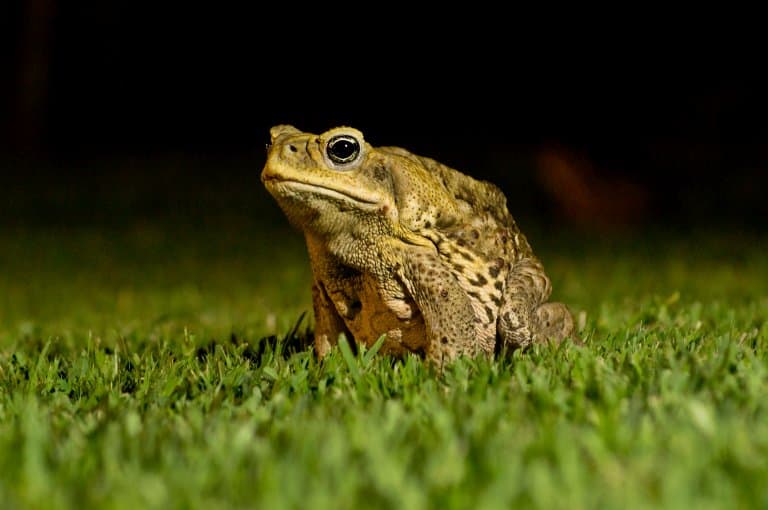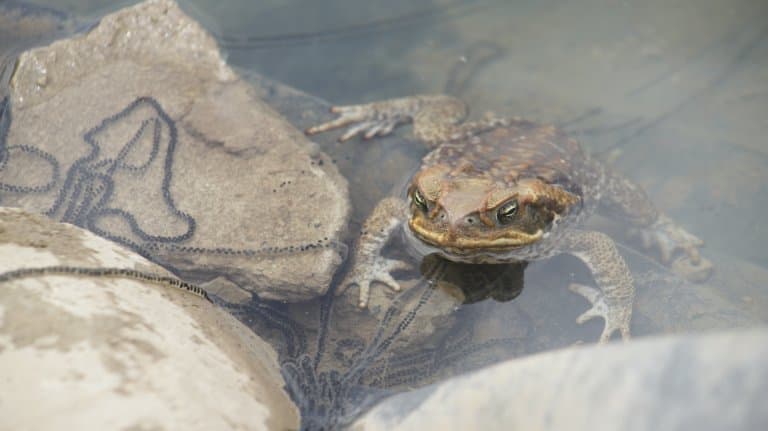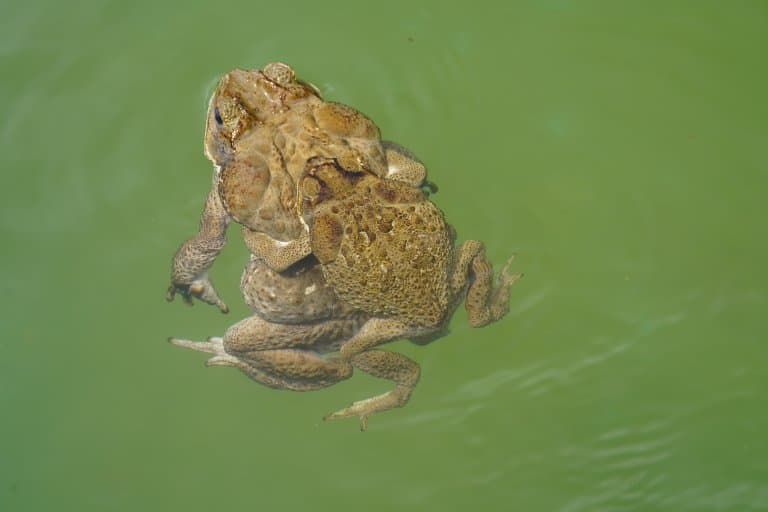Cane Toad Profile
In the ‘90s, Bucky O’Hare tried to warn the universe about the dangers of toads run amok, but this was too little to some countries, who found out first-hand that introducing an animal known for eating everything will likely result in your everything being eaten.
The enormous cane toad is a terrestrial true toad native to South and Central America – that was once the go-to for several countries looking for biocontrol of their pest problems, but nowhere was that mistake more obvious than in Australia.

Cane Toad Facts Overview
| Habitat: | Sandy, coastal grasslands |
| Location: | Native to Central and South America, introduced to N America, Aus |
| Lifespan: | 15 years in the wild, up to 35 in captivity |
| Size: | Up to 25cm (9.5 inches) long |
| Weight: | 2.6kg (5.8lb) |
| Colour: | Green/brown |
| Diet: | Generalist predators, anything small enough to fit into their mouth |
| Predators: | Snakes, Caiman, some fish, eels, crows. |
| Top Speed: | Slow |
| No. of Species: | 1 |
| Conservation Status: | Least Concern |
Cane toads are sometimes called giant toads, or marine toads, and they live in both tropical and semiarid habitats.
It’s understandably frustrating when you have pests in your garden, but the cane toad is a lesson in biocontrol, and a warning against perhaps introducing an animal whose entire lifecycle is toxic to native fauna and doesn’t know the distinguish between a sandwich and a salamander for lunch.
The cane toad is an old species. They are prolific breeders, and even bigger eaters, dieting on both living and dead animals without thought.
They are giants of the amphibian world, capable of withstanding conditions that would crisp up any ordinary amphibian, and they’re likely to outlast all of us.
Interesting Cane Toad Facts
1. You shouldn’t lick them
You might be forgiven for assuming they’d be sweet to taste considering their name, but it turns out cane sugar actually comes from a type of grass.
Cane toads are an entirely different species, and far less suitable for baking. And it gets worse. These toads also contain quite an unpleasant poison, the ingestion of which can kill you.
They are particularly dangerous to dogs if ingested.
Even their tadpoles are toxic, and this generally means Cane toad is off the menu. But there might be other ways to enjoy this enormous amphibian’s sweet, sweet juices. 1

2. They’re probably not smokable either
The Colorado River toad is the species responsible for the toad-licking stereotype. While licking this one still isn’t a good idea, you can (but we’re legally obligated to say you shouldn’t) get substantially enlightened by the hallucinogenic effects of smoking the secretions from its glands.
But the Cane toad is a very different species and the effect of its secretions is thought to be more terminal than hallucinogenic.
Still, these secretions have been traditionally used for medicinal purposes, and the concentrations and proportions of Bufotenin in the poison have yet to be fully explored in an inter-dimensional context.
It’s also very illegal in Australia.
What is known is that animals, including humans, who ingest this poison are in for a rough time.
Head spasms, ventricular fibrillation, seizures, frothing at the mouth and plenty of other wonderful symptoms are commonly seen in response to intoxication, and dogs, cats, and any other mammalian toad-lickers are at risk.
It should go without saying that smoking random toad venom is a silly idea, but it might not even be the silliest idea that people have had with this species.
3. Their name is no coincidence
While native to Central and Northern South America, these toads are notorious for being a destructive force in countries where they became invasive.
As is often the case, the deliberate introduction of this species had unforeseen (or possibly well-foreseen yet disregarded) repercussions when they were brought in as pest control for sugar cane crops.
The pest in need of control was the French’s ‘cane beetle’, which, despite the name, is a native species to Australia. The sugar cane it made a name eating, however, is not.
So, you’ve got an invasive species, eating a native species, eating an introduced species. What could go wrong?

4. A lot went wrong
Cane toads are remarkably tough for amphibians.
Most of their class are fragile animals; canaries in the coal mine of their habitats, sensitive to the slightest ecological shift; their early deaths act as harbingers of disastrous ecological change to come.
Not cane toads. They can live anywhere, and eat anything. They are the disastrous ecological change. At least within the local climate of Australia’s vast sugar cane plantations.
When Australians brought sugar cane over from New Guinea, the local French’s beetle developed a voracious appetite for it. When the subsequent toads were brought in to subdue the beetles, the toads showed everyone what voracious meant.
Like (almost) all toads, cane toads swallow whatever fits into their mouths. Not satisfied simply with beetles, they branched out into their new habitat like a 19th-century naturalist, sampling as many different animals as they could get on their plates.
They went after honeybees, spiders, frogs, and bird’s eggs, and with no natural predators, multiplied with impunity. In fact, would-be predators, having never seen a cane toad before, had no idea how toxic they were, so even larger native animals were killed when they attempted to eat one. 2
5. Cane toads are a serious threat to quolls
The cane toad has had a significant negative influence on quoll populations in Australia.
Australia’s northern quoll species in particular, has a fondness of the cane toads poisonous flesh. As a result, the northern quoll is now considered to be nationally endangered.
Researchers have identified some quolls that choose to avoid cane toads, and subsequently devised a technique to pass on their non-toad eating habits to future generations to help their plight.
6. They live in sand
These toads are so hardy that their original name, Bufo marinus, referred to the mistaken understanding that they could live in seawater. This is because they have an exceptional tolerance to dehydration and use this to occupy sandy dunes in coastal areas.
This is one of the reasons they were so well suited to Australian environments, and since nothing can eat them, and they can eat everything, they’ve managed to expand from a pioneering population of around 102, shipped in a box from Hawaii, to a healthy and omnipresent 200,000,000.
7. A female can lay up to 25,000 eggs
Cane toads are prolific breeders, and they start lives as an egg in long strings of jelly like substance. Tadpoles will hatch from these eggs, which take 12-60 days to develop into juvenile cane toads.
Not all tadpoles make it, as many creatures will try and eat them even though they are toxic, and they also cannibalise their siblings.
Somewhat thankfully, only an estimated 0.5% of cane toads reach adulthood.

8. Climate change will make this worse
This toad has already staked its claim on 500,000 square kilometres of Australia’s habitat, invading and wreaking havoc on native island wildlife.
Island ecosystems are unique and inherently more fragile than most, and while the toad has invaded other countries, typically, their effect is dampened by the resilience of the local wildlife.
Australia is particularly vulnerable to this invasion, and it’s thought that if climate predictions are accurate for the island, the cane toad’s range will likely expand further.
9. They can’t jump well
These enormous toads do have some limitations. Their large mass and clumsy nature make them poor climbers and they have the kind of jump you’d expect from a great big fatty that eats everything.
Of all the oversights in this mess, this one may have been the most ironic, since a toad that could do what toads are known for might have been able to reach the adult beetles higher up on the sugar cane’s leaves.
So, after all this mess, the sugar cane was no better off and the local fauna was severely threatened. But this lack of agility does hold the key to limiting the destruction of the largest toad on earth.
While native frogs can climb, a well-placed fence should significantly restrict the movement of the bulbous cane toads, and help divide and conquer. 3 4
10. They are the largest toad in the world
In 1991, the record for the heaviest toad was set by a pet cane toad in Sweden. This is likely the largest toad ever recorded, and almost twice as heavy as the average.
The toad weighed 2.6kg and was nicknamed Toadzilla.
11. Some animals are figuring out how to kill them
Remarkably, social evolution is happening right in front of our eyes. Native bird species in Australia are showing why they survived the K-T extinction and are figuring out where the non-toxic parts of this toad are.
It’s said that in the last 60 years, some crows have learned how to turn the frog over and access the juicy organs, avoiding entirely the toxic parts of the skin.
Crows are some of the smartest animals on the planet, and if they can pass this information on to their conspecifics, toad control might be a little closer than we imagined.
Meat ants are also unaffected by their toxin, so as a cane toads tactics to be attacked is standing still and letting their poison kill attackers, these ants will cover the toad and eat it. 5
12. Their toxins have been utilised in various ways
Other than biological control for pests, cane toads have been put to other use.
- They are milked by tribes in South America for their toxin, which is then used on arrow tips to poison prey.
- They are hunted in parts of Peru as food. When properly prepared, they can be eaten and are considered a healthy food source with omega-3 fatty acids.
- In Japan they have been used as an aphrodisiac and a hair restorer.
- In China they have been used in cardiac surgery to lowe heart rates of critical patients.
- Cane toad skin is made into leather and novelty items.
Bufotenin is still being explored by laboratories for other medicinal uses.

Cane Toads Fact-File Summary
Scientific Classification
| Kingdom: | Animalia |
| Phylum: | Chordata |
| Class: | Amphibia |
| Order: | Anura |
| Family: | Bufonidae |
| Genus: | Rhinella |
| Species: | Rhinella Marina |
Fact Sources & References
- Konnie H. Plumlee (2004), “Bufotoxin”, Science Direct.
- Tina Butler (2005), “Cane toads increasingly a problem in Australia”, Mongabay.
- “Excluding Cane Toads from Water Bodies”, NSW Environmental Trust.
- Daniella Master Herpetologist (2023), “Why Were Cane Toads Introduced?”, Toads n Frogs.
- NOELLE DUERWALD (2018), “Crafty Crows Learn to Eat Poisonous Cane Toads”, Island Conservation.
